
Hope for a huge, ancient and imperilled fish
First Nations are leading efforts to make sure lake sturgeon can find a home in...
Anzac Valley, B.C. — Retired B.C. government forester Judy Thomas bushwhacks down a steep incline in B.C.’s Anzac River valley, north of Prince George, in search of a spruce beetle the size of a mouse turd.
To find one of the marauding insects Thomas has to chop through the coarse bark of an old-growth spruce to its soft inner layer, where a single beetle lays as many as 1,200 eggs. Extended ‘galleries’ of beetle larvae feed on the sapwood, killing the tree in tandem with an associated blue stain fungi.
“Let’s see if they’ve flown the coop,” says Thomas.
She points to telltale signs that the tree, still green and healthy-looking, has been under siege as part of the largest spruce beetle infestation B.C. has witnessed in 30 years.
Frass — a reddish brown sawdust-like substance that is a mixture of beetle poop and chewed tree debris — is sprinkled in bark crevices. The bark also has pitch tubes, appearing as tiny blobs of sap, that form as the tree tries to expel its miniature attackers.
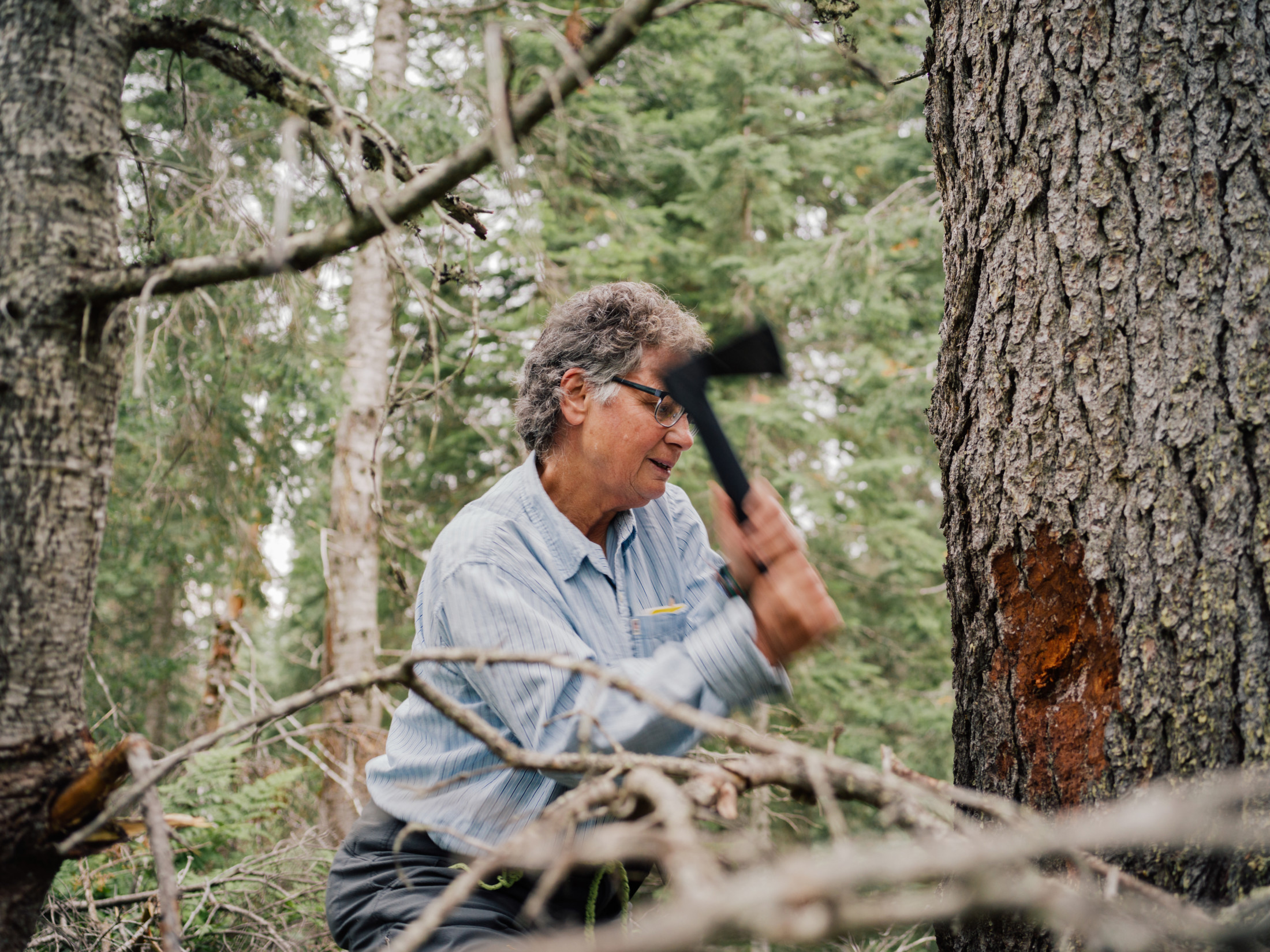
Thomas cuts away at the bark of a spruce tree in search of beetles. Photo: Taylor Roades / The Narwhal
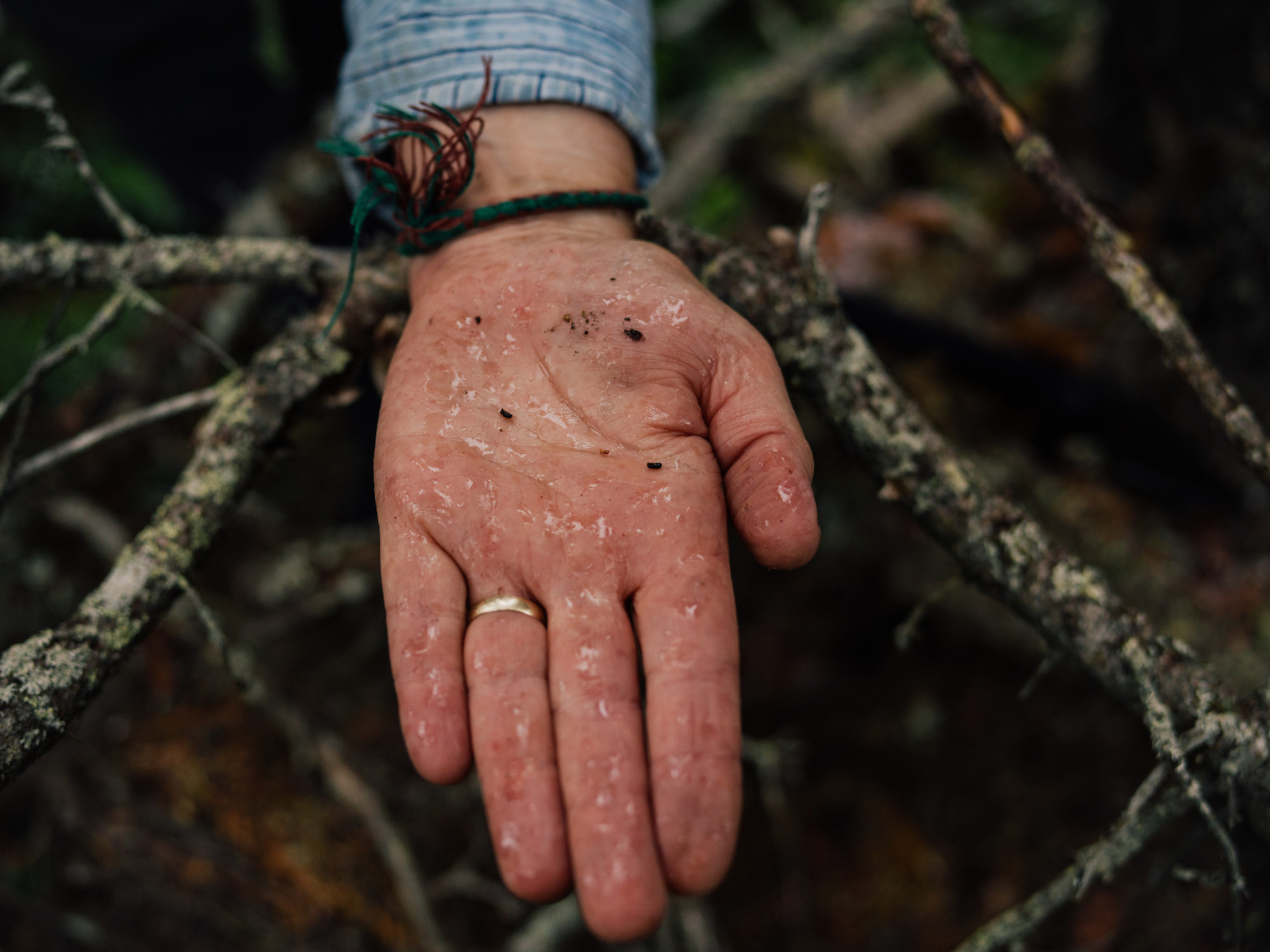
Thomas discovered small insects in the spruce bark but none of them bore the telltale reddish-brown back of spruce beetle. Photo: Taylor Roades / The Narwhal
Thomas slashes at the bark with precision. A few minutes later there are three tiny black bugs in her hand. But none bear the distinctive markings of a spruce beetle — stout and cylindrical, with brown-black or reddish-black wing covers.
The beetles have flown, she says.
You don’t have to venture far from Prince George to find evidence of the spruce beetle eruption that in 2018, according to the B.C. forests ministry, affected 340,000 hectares province-wide, an area 18 times the size of Salt Spring Island.
Forests are tinged with red. Stacks of spruce logs line mill yards. In the Anzac River Valley, habitat for endangered mountain caribou, fresh clear-cuts spiral out from logging roads lined with slash piles waiting to be burned.
The eruption is underway just as the supply of mountain pine beetle salvage wood dries up and forest-dependent communities struggle with job losses due to mill closures and curtailments.
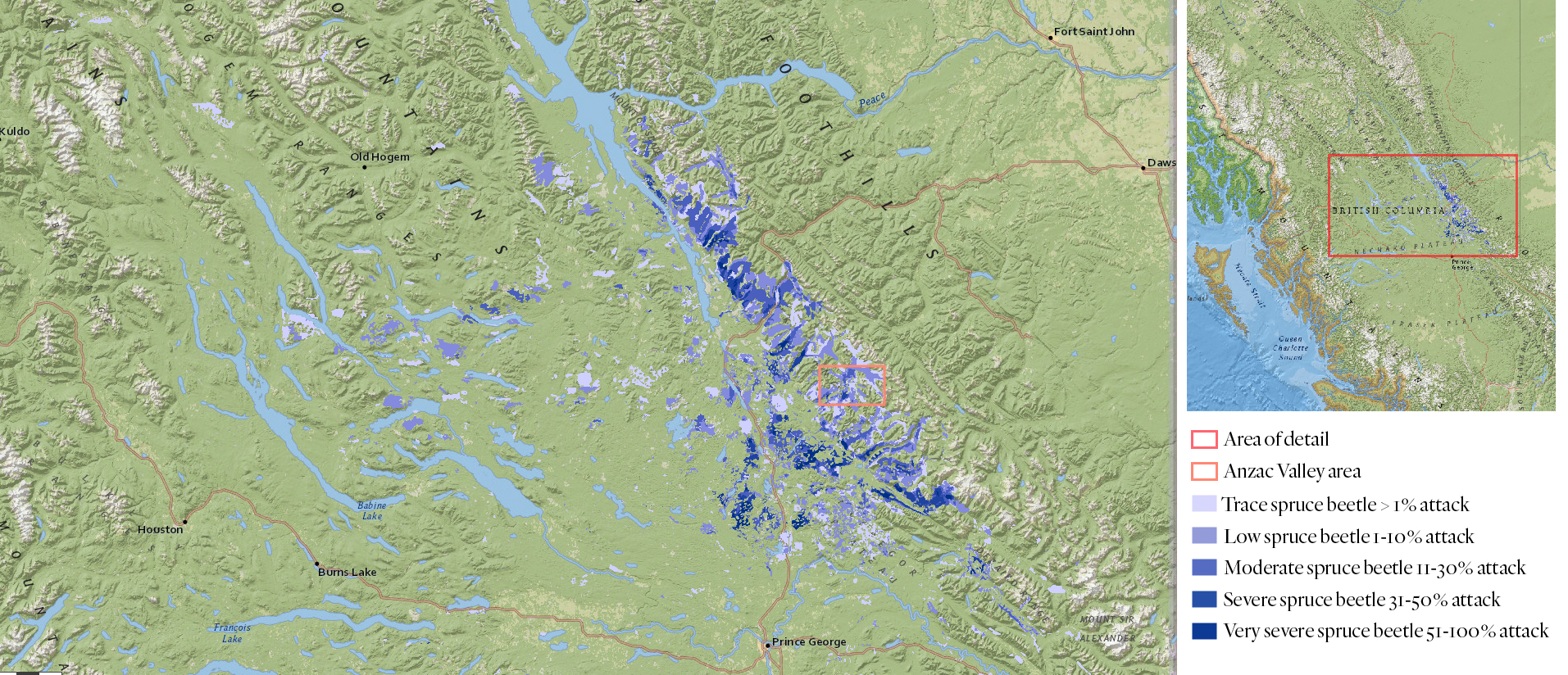
Area affected by spruce beetle. Source: B.C. government. Map: Carol Linnitt / The Narwhal
According to the B.C. forests ministry, timber harvesting in hard-hit areas like the Prince George region balances the “need to control the beetle’s spread” while minimizing the beetle’s impact on forest resources and “maximizing timber recovery before the wood quality deteriorates.”
“Harvest operations in the region are strategically targeting stands to reduce beetle populations and still recover the economic value of the timber over the long-term,” the ministry said in an emailed statement in response to questions from The Narwhal.
But scientists say you can’t log your way out of a spruce beetle eruption.
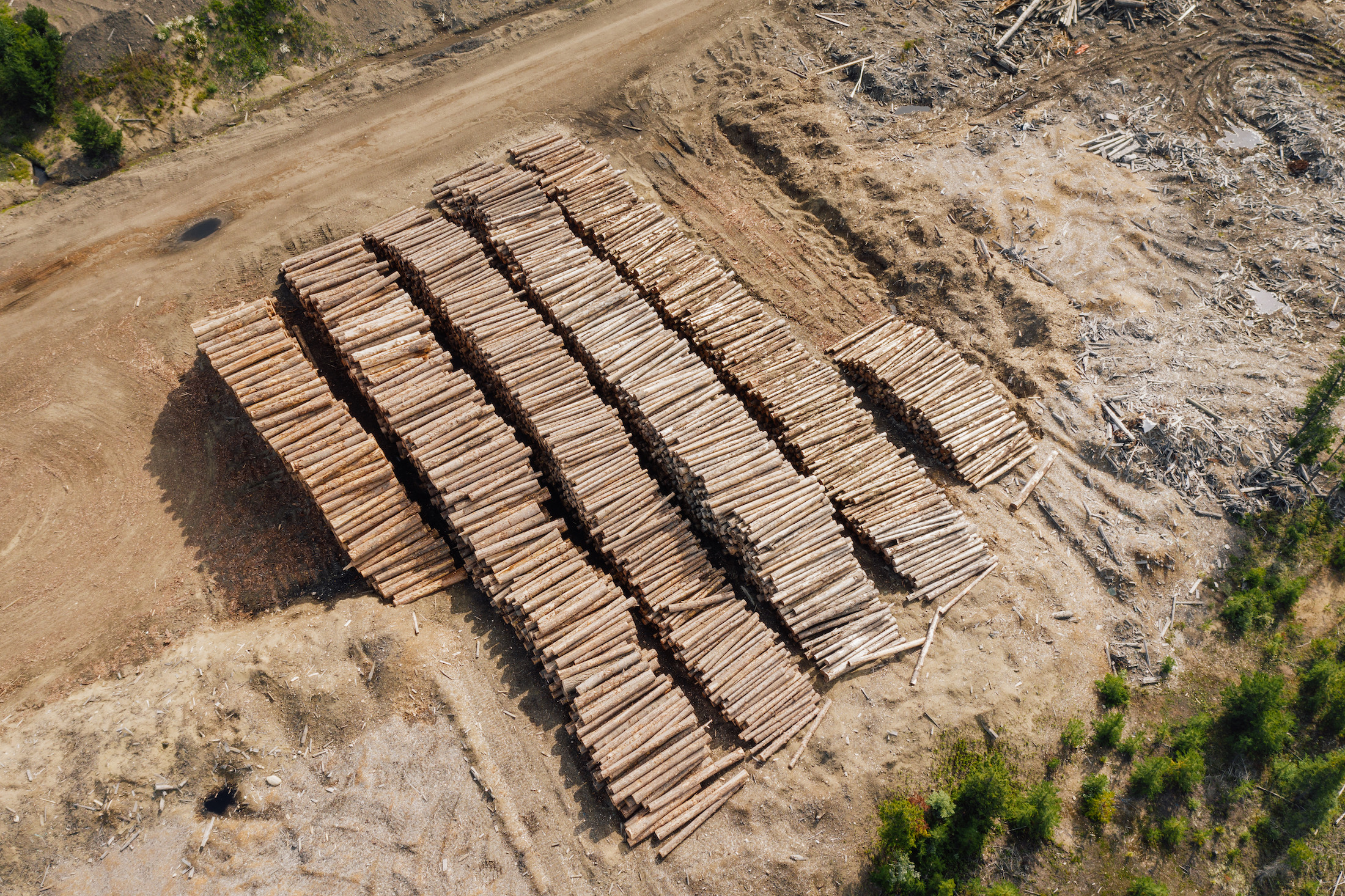
Log piles at Canfor’s Polar Mill, near Prince George, B.C. Many trees are logged as an outcome of ‘bycatch,’ according to Michelle Connolly of Conservation North. Photo: Taylor Roades / The Narwhal
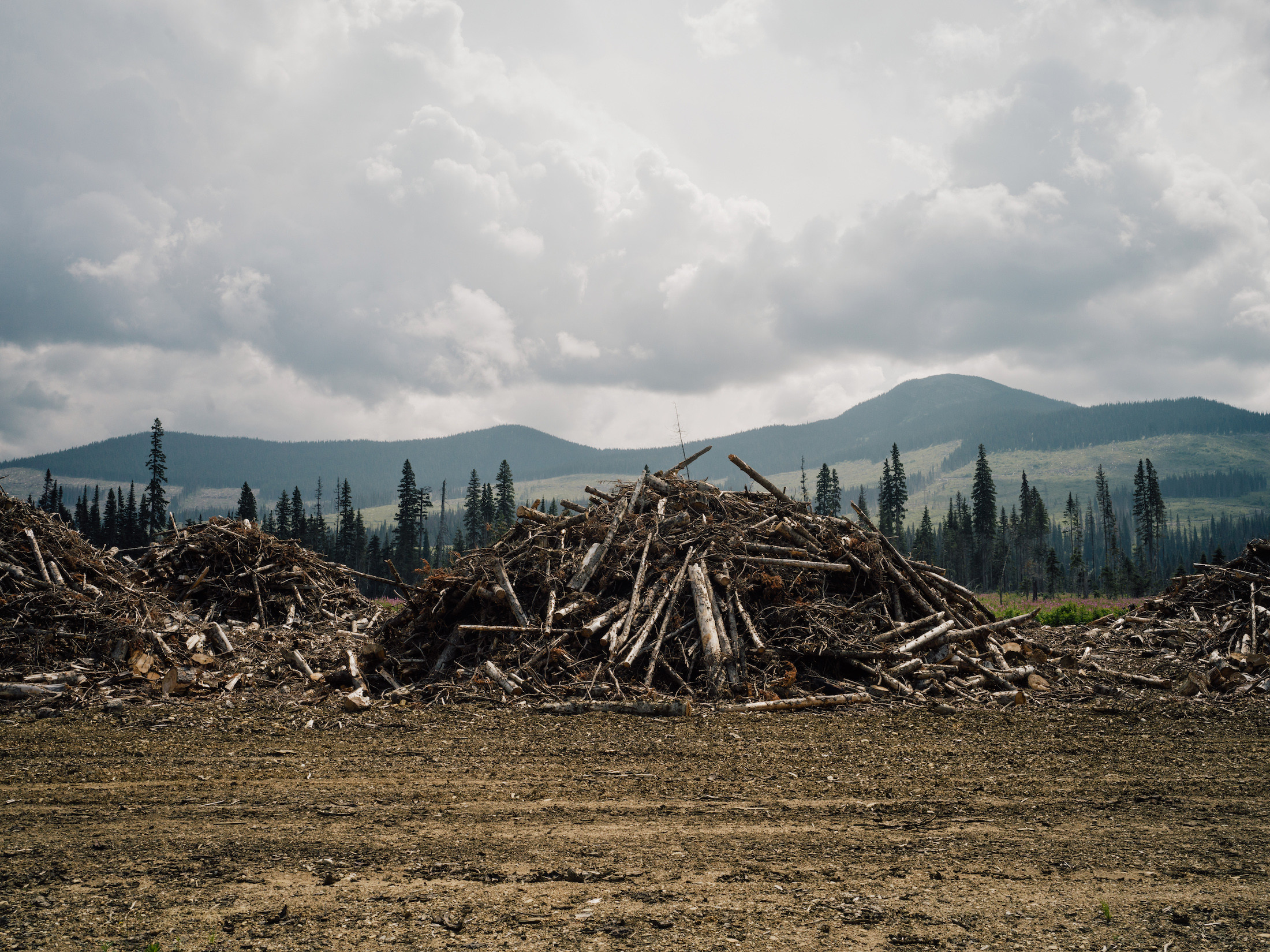
Clear-cut logging in spruce beetle-affected areas in B.C.’s interior. Photo: Taylor Roades / The Narwhal
And the science-based group Conservation North is concerned that the spruce beetle outbreak is giving logging companies license to accelerate clear-cutting in increasingly rare old-growth spruce forests like those found in the Anzac, Hominka and Table watersheds.
These valleys are part of an ecosystem called the interior wet belt that provides habitat for at-risk species ranging from songbirds and bull trout to grizzly bear and wolverine. Because it’s so wet, the forests are largely undisturbed by fire, giving rise to slow-growing and old trees covered in lichen, a crucial winter food for caribou like the endangered Hart ranges herd, whose habitat includes the Anzac valley.
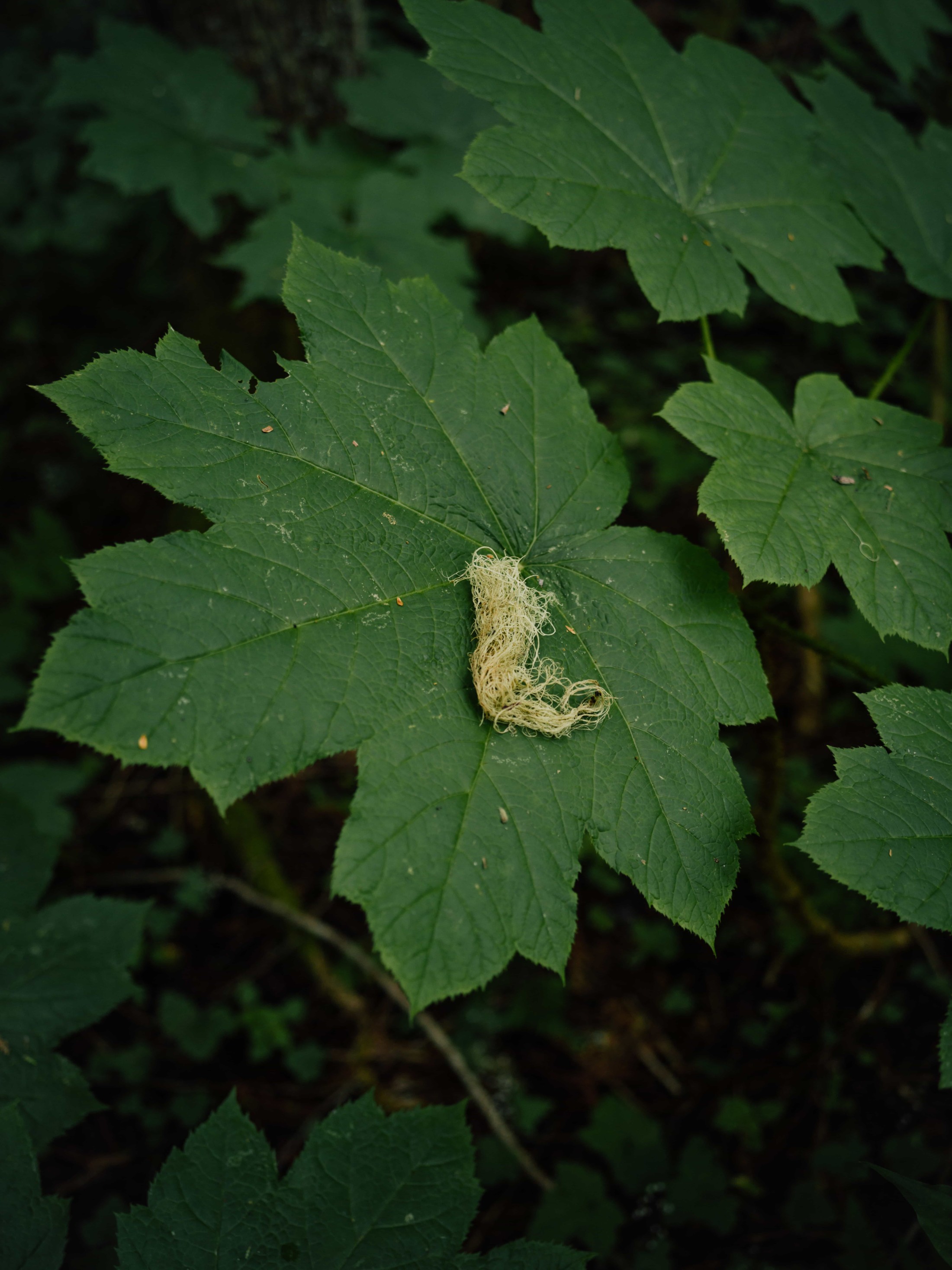
Lichen, which only grows on old trees, feeds mountain caribou in the winter. Photo: Taylor Roades / The Narwhal
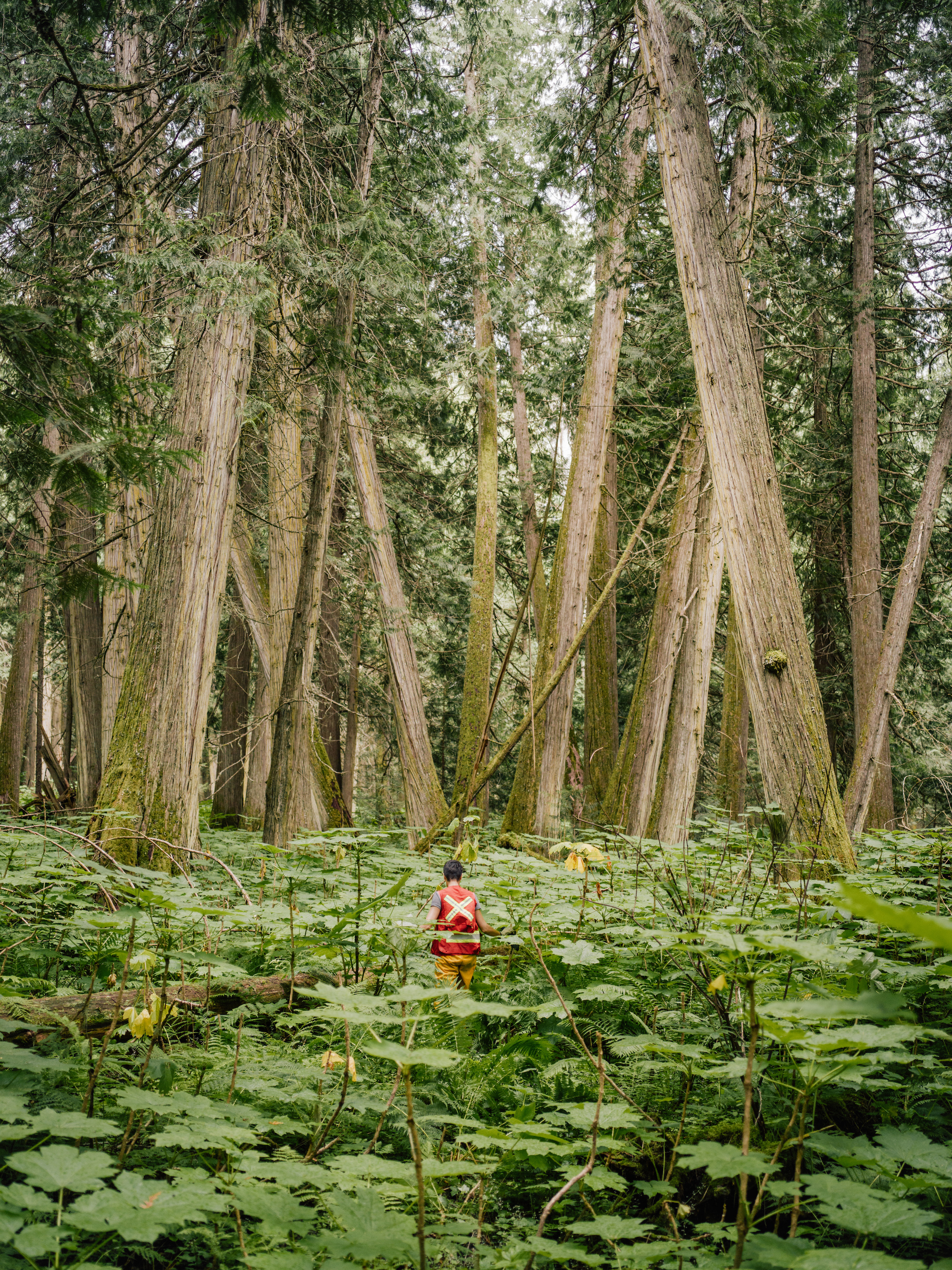
Connolly in an area of B.C.’s inland temperate rainforest that contains stands of ancient cedars, some estimated to be 1500 years old. Photo: Taylor Roades / The Narwhal
Scientist Diana Six, a North American expert in bark beetles, says you can’t manage a spruce beetle eruption by logging.
“This idea that you can log your way out is incorrect,” Six, a professor of forest entomology and pathology at the University of Montana, tells The Narwhal.
“Clear-cutting is probably one of the worst things you can do … It reduces the resiliency of those forests to recover. You’re removing the small stuff that could replace that forest, you’re removing most of the ecosystem. You’re removing seed sources.”
“It adds insult to injury, without achieving the goal, if the goal is indeed to help the forest recover or survive the beetles.”
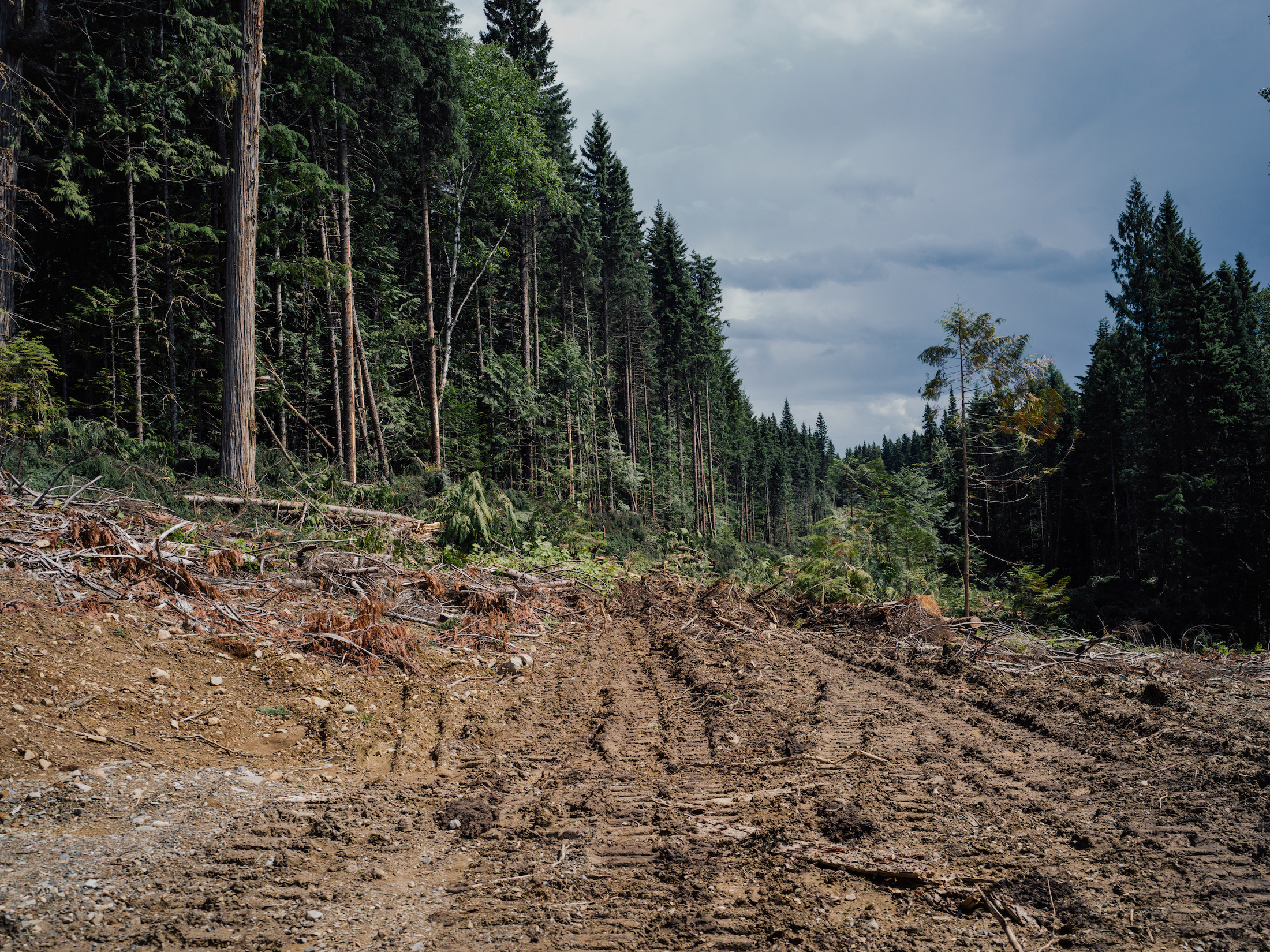
Clear-cut logging in a part of B.C.’s inland temperate rainforest rich with old-growth red cedar and old-growth spruce trees. Photo: Taylor Roades / The Narwhal
Bulldozing roads and creating other disturbances in spruce beetle-infested forests will often have more of an impact than the beetle itself, says Six, associate editor for the journals of Insects, Journal of Economic Entomology and Agricultural and Forest Entomology.
“When these beetles go through they typically kill the big trees. They don’t kill the young ones because they can’t. That’s just too small of a food source for them. If you go in and do all this kind of logging and trampling and road-building that is going to disrupt this natural process of recovery, substantially.”
“These forests have been through outbreaks for millennia.”
Like the mountain pine beetle, the spruce beetle is native to North America and is always found at background levels. Population explosions are sparked by changes in environmental conditions, such as warmer winters and increased periods of drought related to climate change.
Both mountain pine and spruce beetles can quickly adapt to changing conditions. They have an “antifreeze” gene they can turn on within a few hours of the temperature dropping to the freezing point, so the milder winters experienced in the north, compared to winters decades ago, don’t have much of an impact on populations.
But unlike the mountain pine beetle, which attacks lodgepole pine forests, killing virtually every tree, spruce beetles typically attack only older spruce trees in diverse forests. Spruce beetles also spread more slowly than mountain pine beetles and can leave much of the forest and its understory intact.
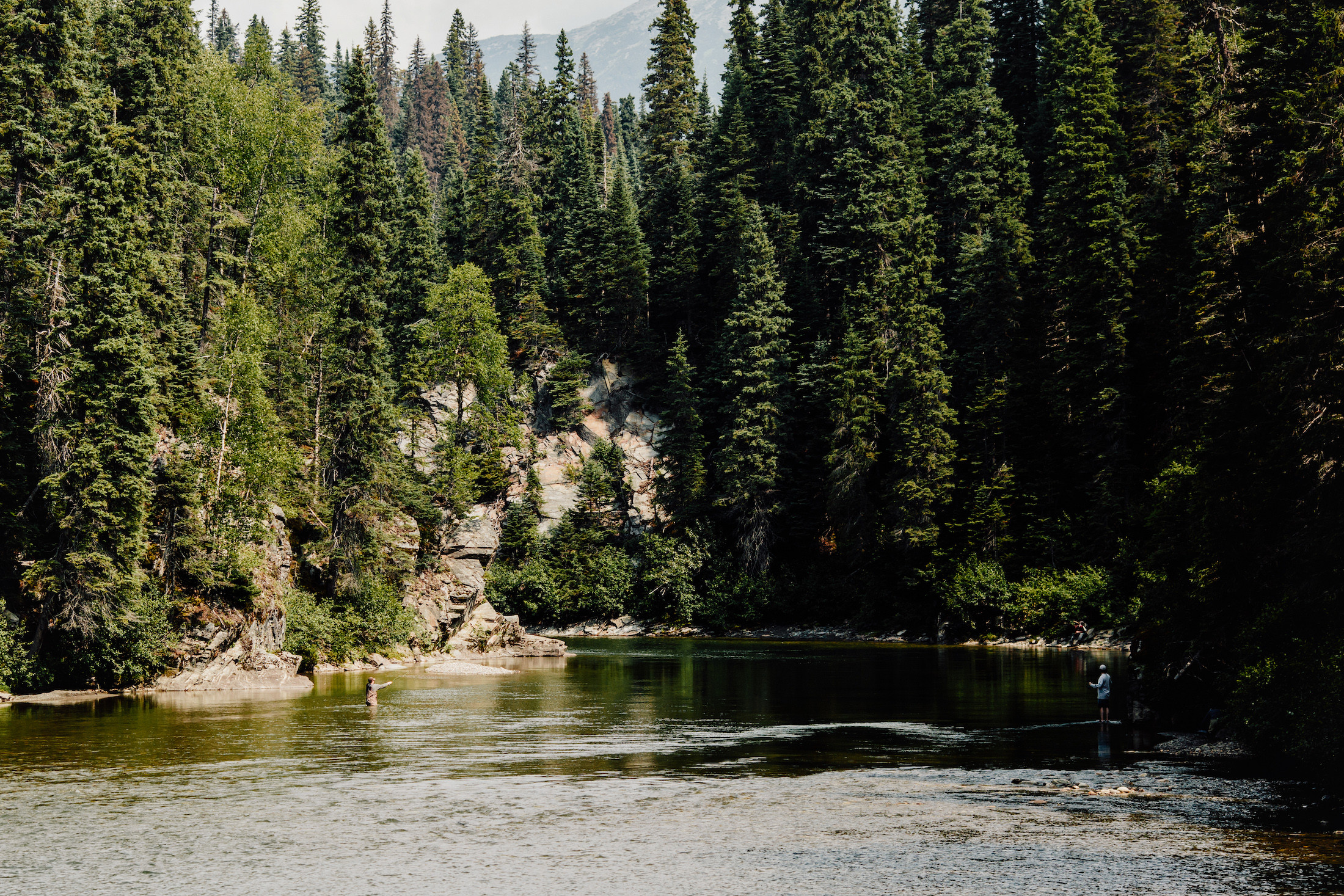
The Anzac River flanked by spruce trees. Trees affected by spruce beetle can be seen in the distance. Photo: Taylor Roades / The Narwhal
During large infestations the spruce beetle can speed up its life cycle, completing it in one year instead of the average two. That makes it more difficult for woodpeckers, the spruce beetles’ main predator — along with predators and parasites such as small flies, wasps and other beetles — to keep the pests in check.
“Woodpeckers can remove a lot of beetles over a season,” Six explains. “When the populations are low to moderate they have an impact.”
But nothing can keep pace with spruce beetles when the environmental conditions are right.
“The only way you can remove that susceptibility is if you were able to turn on the rainfall, turn down the thermostat, change the underlying conditions,” Six says.
“As long as the trees are stressed and conditions are warm enough for the beetles to reproduce they’re going to keep going. And it doesn’t really matter how many trees you remove.”
Prince George forest ecologist Michelle Connolly says it has become standard practice for forestry companies to log “an area far larger than the beetle is actually in.”
“It’s an excuse to really hammer valleys,” says Connolly, director of Conservation North, a non-profit group headquartered in Prince George. “Spruce beetle has been an effective way of generating political momentum to log.”
“I think they should just admit that they want to take the lumber before it loses economic value instead of pretending that there’s some kind of scientific rationale for industrially logging areas when spruce beetle populations go up,” Connolly tells the The Narwhal.
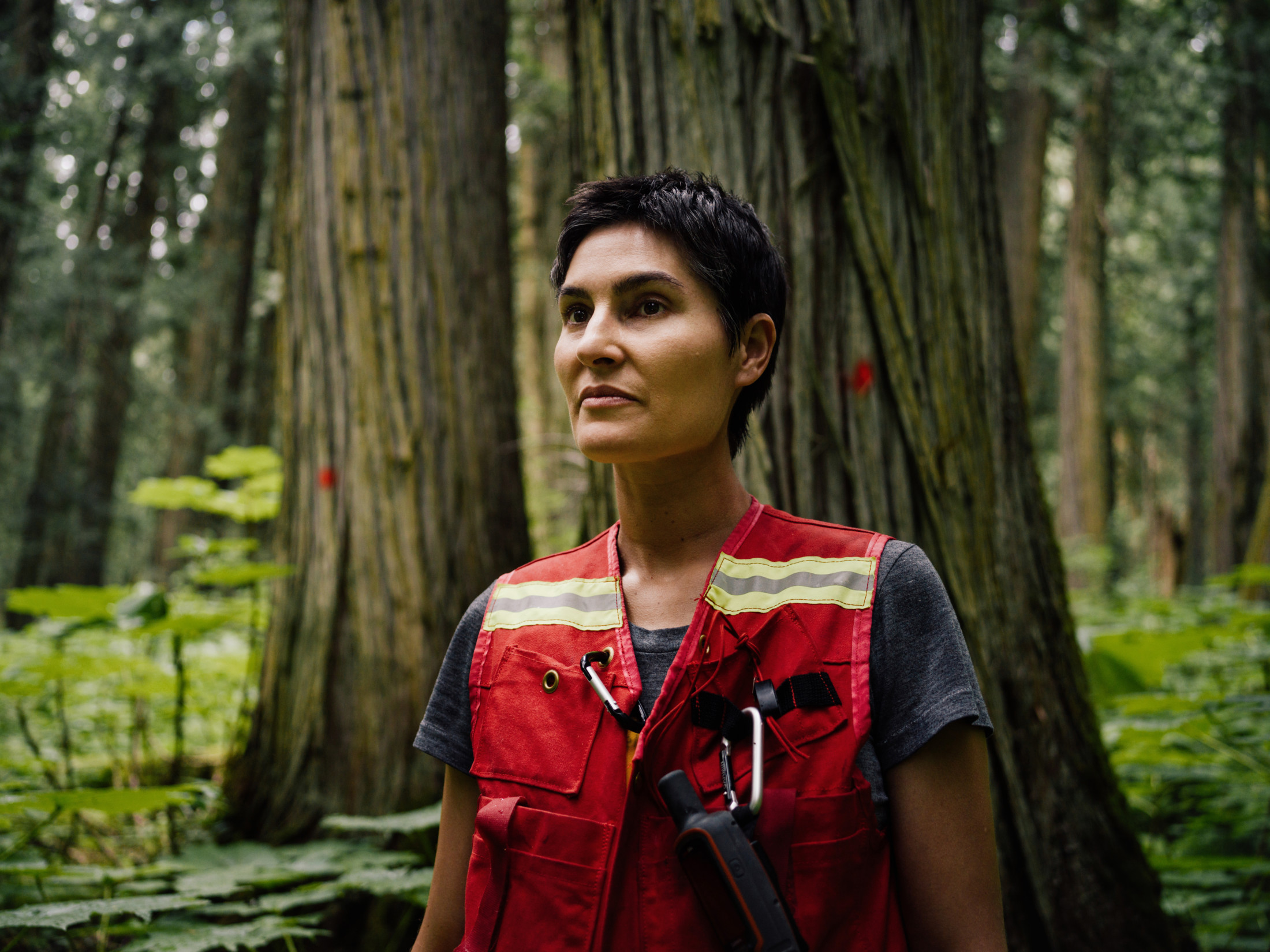
Forest ecologist Michelle Connolly is concerned the spruce beetle outbreak has given logging companies license to accelerate logging in old-growth forests that are home to endangered species such as mountain caribou. Photo: Taylor Roades / The Narwhal
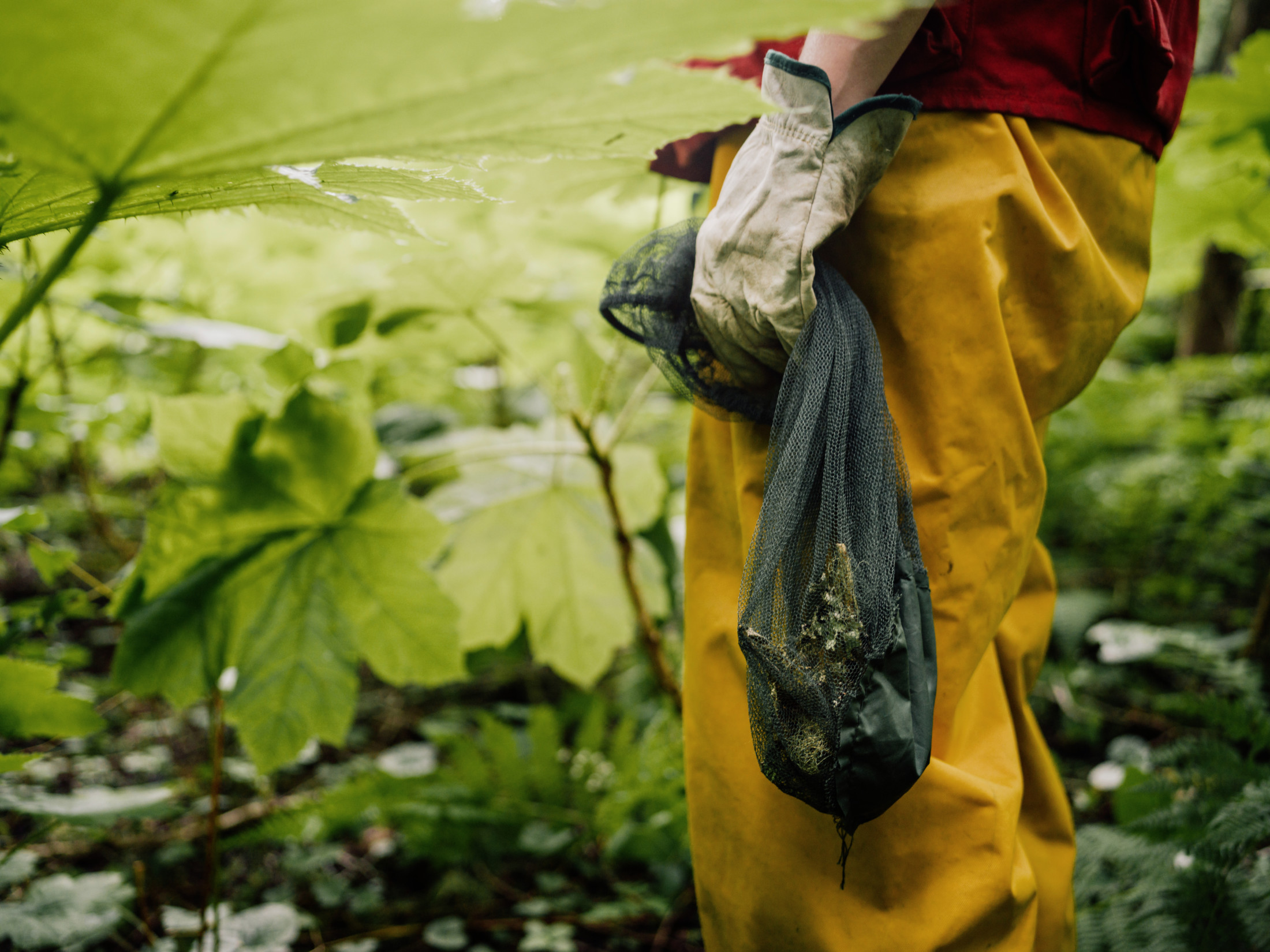
Connolly collects inland rainforest lichens that can include a diverse range of species including toad whiskers, resembling five o’clock shadow, on the underside of leaning trees and Methuselah’s beard, which grows up to three or four metres in length and is wrapped around tree branches by the wind. Photo: Taylor Roades / The Narwhal
“The biggest threat to primary forests in the wet belt is not the beetle, it’s industrial logging.”
Founded in 2017, Conservation North is raising the alarm about the rapid destruction of primary forests in B.C.’s interior — including the rare inland temperate rainforest where cedar trees are more than 1,000 years old — and the accompanying loss of biodiversity at a time when scientists say our planet is in the middle of its sixth mass extinction and is experiencing the most rapid loss of species since the elimination of the dinosaurs 65 million years ago.
In April, Connolly and other Conservation North members filmed thousands of spruce logs piled along forest service roads in the interior rainforest and spruce snow forests near Prince George.
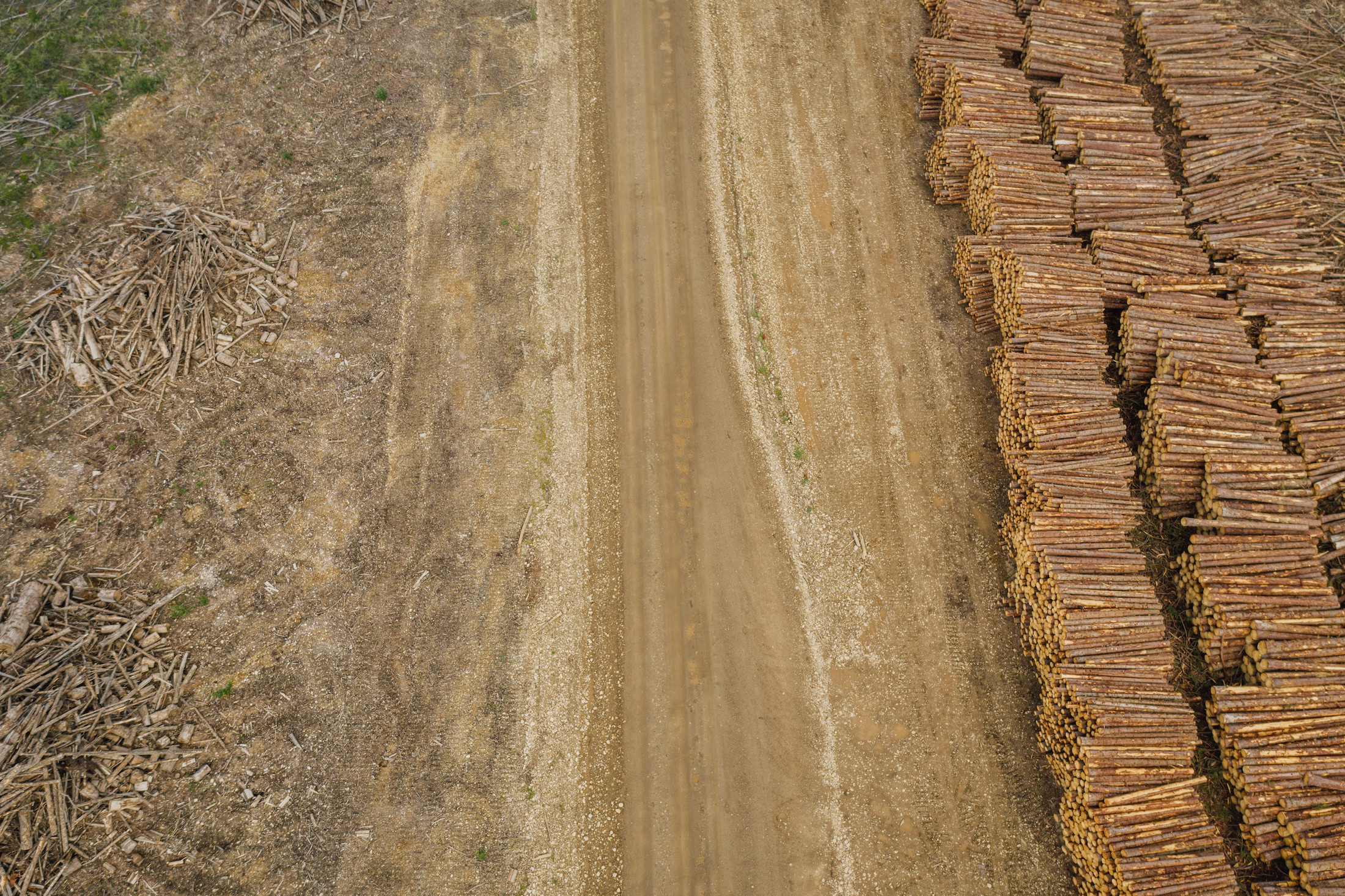
Piled logs and slash piles of waste in the Anzac River Valley near Prince George, B.C. Photo: Taylor Roades / The Narwhal
Forestry companies “probably got it for 25 cents a cubic metre because it was scaled as low-grade logs,” instead of at a much higher rate of at least $10 per cubic metre — and possibly as high as $40 per cubic metre — for wood untouched by the beetle, she says.
“Examining those logs, three-quarters of the spruce had no sign of beetle attack,” Connolly says. “It’s ‘by-catch.’ ”
The forests ministry did not respond to a question from The Narwhal asking if there is a certain density of spruce beetle that needs to be found before companies conduct salvage logging — the harvest of timber that is dead, infested with pests or otherwise damaged.
The ministry also did not respond to a question asking how many hectares of the Anzac valley and other areas of B.C. have been clear-cut due to the spruce beetle.
Connolly says her understanding is that much of the clear-cutting in the Anzac valley since 2017 has occurred because of the beetle.
The forests ministry does not have the right to refuse a cutting permit when timber companies apply for one within their license areas, and information about where specific cutblocks will go is not publicly available until after logging has occurred.

Connolly uses GPS to track clear cut areas in the Anzac Valley. Photo: Taylor Roades / The Narwhal
“Licensees are being asked to harvest spruce beetle impacted areas prior to harvesting green, live timber,” the ministry said in an email. “This helps to slow the spruce beetle from spreading, and allows licensees to sell the damaged timber while it still has value.”
Ecologist Roy Rea, an instructor for the University of Northern B.C.’s Ecosystem Science and Management Program, says there are compelling reasons to improve on ways we are logging spruce beetle infested forests.
Rea points to a 2017 document from Diane Nicholls, B.C.’s chief forester, which outlines expectations for harvest prioritization in response to spruce beetle outbreaks.
The word “retention” or “retain” was used more than 60 times in the 18-page document, notes Rea, who teaches a forestry field school.
“The chief forester has said we really need to focus on increasing our ability to leave things behind.”
“While we work to harvest attack trees, we should seek to leave more healthy trees behind.”
But there is no obligation for logging companies to follow the chief forester’s guidelines when harvesting timber in spruce beetle-infested forests.
“What we need to recognize is that they’re obviously better ways of doing things,” says Rea, who worked on a logging crew and in a sawmill in his younger years.
“Are they as economically feasible as clear-cut logging? No.”
On a three-day summer field trip into forests and logging areas around Prince George, including to the rare ancient temperate rainforest, The Narwhal saw no evidence that Nicoll’s expectations about forest retention are being followed.
In the Anzac valley, massive clear cuts stretched in every direction in the spruce-dominated forests, including through what was recently habitat for the endangered Hart Ranges mountain caribou, where the B.C. forests ministry issued 78 new permits for clear-cutting over a recent nine-month period.
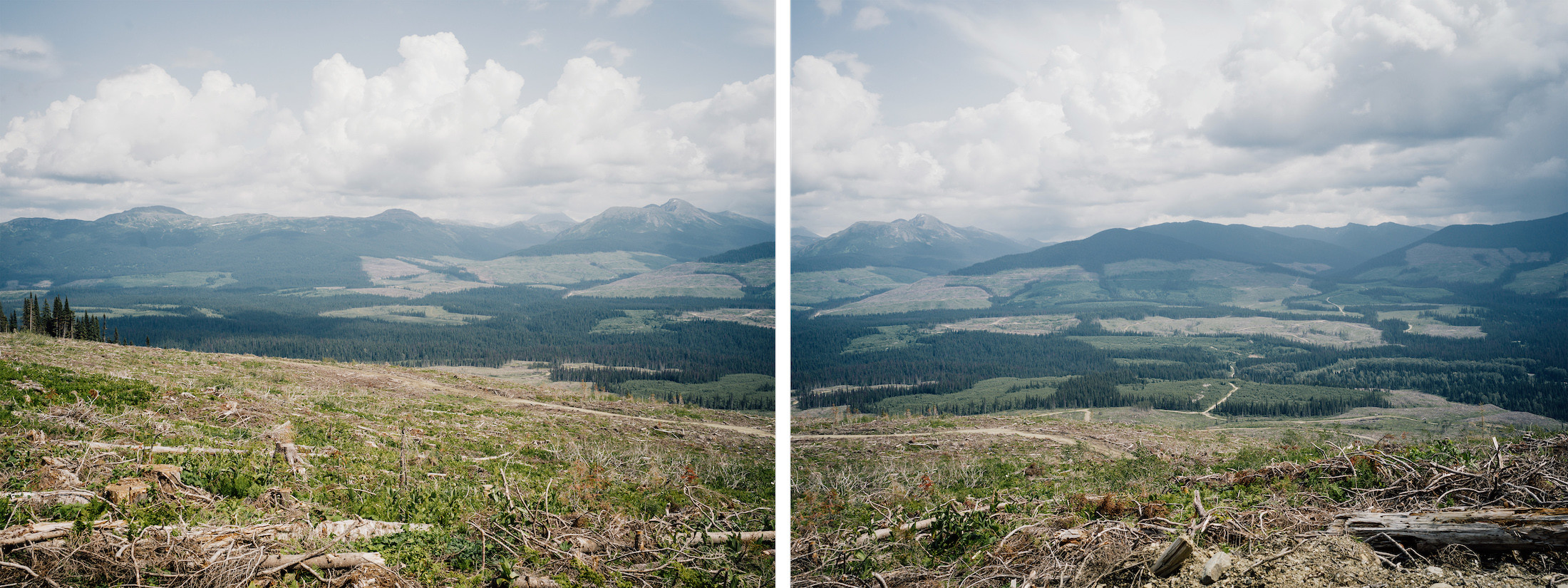
Clear cut logging in the Anzac River Valley. The valley bottom, where caribou migrate to find lichen during deep-snow winters, is also slated to be logged. Photo: Taylor Roades / The Narwhal
“The province and the professional foresters who are allowing this are supposed to be concerned with other ‘objectives’ like species at risk, other wildlife, water, and the public interest,” Connolly points out.
“Even the chief forester has given warning in her recent guidance documents to the forest industry that we should be doing partial cutting, and yet we have not seen a single block that isn’t hundreds of hectares of moonscape.”
Salvage logging for spruce beetle continues in the Anzac valley even though the area attacked by spruce beetle in the Omineca region, which includes the valley, dropped by almost 100,000 hectares from 2017 to 2018, according to figures provided by the B.C. forests ministry.
Province-wide, spruce beetle-attacked areas fell by 160,000 hectares over the same one-year period, according to the ministry, which said it is too early to determine if the outbreak is declining. Data for 2019 will be available in November.
Rea also points to the recent United Nations’ Global Assessment Report on Biodiversity and Ecosystem Services, which examines the ecosystem services provided by healthy forests, including water and carbon sequestration.
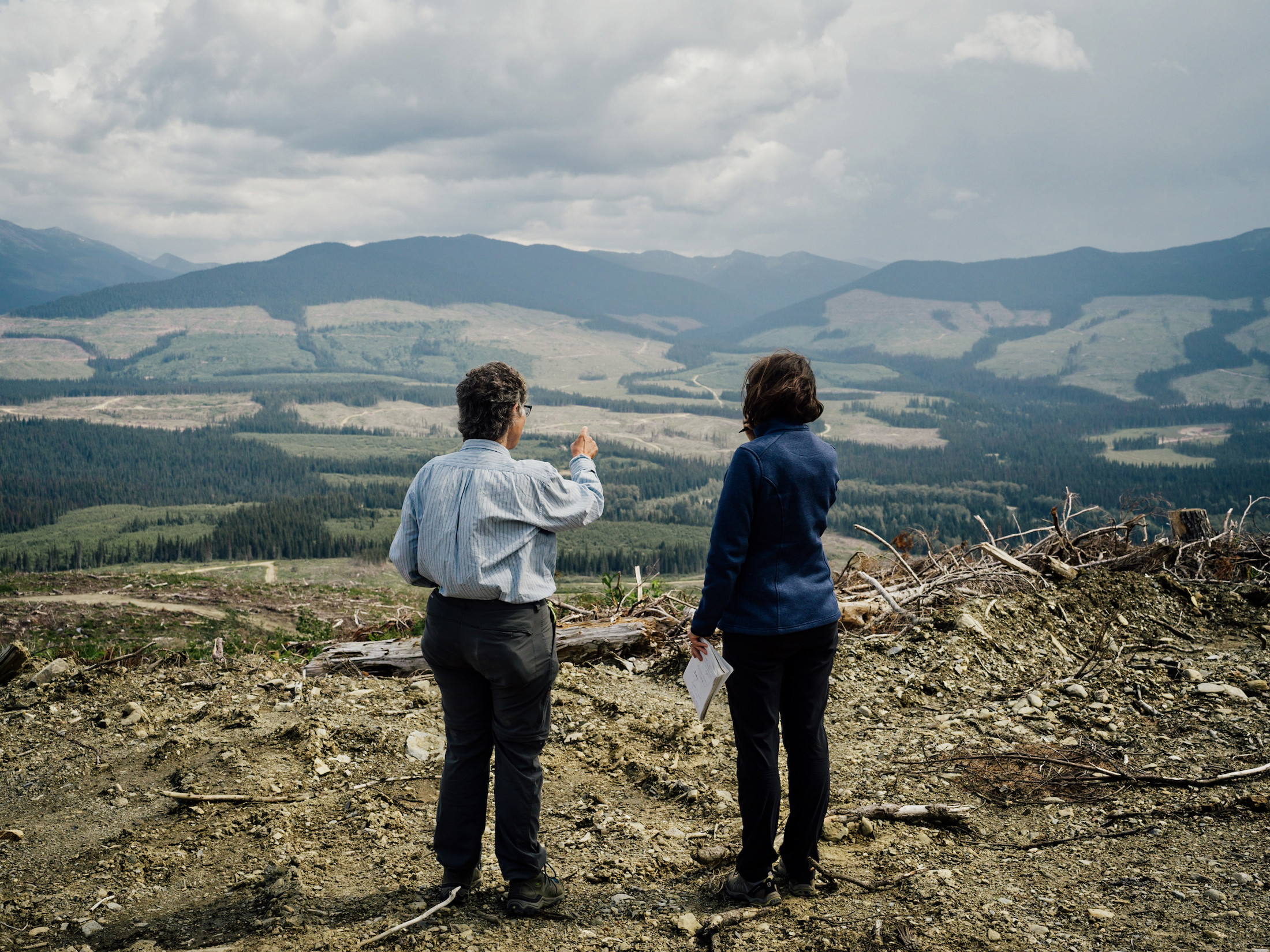
Judy Thomas surveys clear cut logging in the Anzac Valley with journalist Sarah Cox. Photo: Taylor Roades / The Narwhal
“They were basically pleading with communities around the world to start thinking about ways of doing things differently,” he notes.
“They said what we’ve been doing over the last several decades doesn’t appear to be working. The climate is changing. We’re losing biodiversity … This isn’t just stuff that’s happening on palm oil plantations in Indonesia. This is happening in our own backyard. And we all have to pitch in and figure this thing out.”
Even moose populations are in sharp decline in northern B.C., Rea points out.
“Nobody knows why. But the current working hypothesis proposed by government officials is that it has to do with landscape (habitat) change. Nobody ever suspected that we could possibly hemorrhage 70 per cent of our moose population in northern British Columbia in [the last] 15 or 20 years.”
Spruce beetles are drawn to windfall like wasps are to sugar water, favouring the downed wood over anything green and standing. Falling a few older spruce has long been a strategy to temper beetle outbreaks.
Once a year, in summer, spruce beetles fly in huge swarms. Most travel only a few hundred metres but a “substantial number” fly up to several kilometres away, according to Six. If beetles make their way into a wind column, they are capable of landing tens or hundreds of kilometres away, she says.
“They fly. They mass attack. They lay their eggs. And then you don’t see them flying again for another year because it takes that long for the larvae to develop to new adults.”
Six, whose research also focuses on how bark beetles affect the ability of forests to adapt to climate change, says trees that survive spruce and pine beetle outbreaks may be genetically more resistant to both beetles and a changing climate.
“These outbreaks likely act as major natural selection events,” says Six, the co-author of a peer-reviewed paper, “Are Survivors Different?” that examines why some mature trees survived a mountain pine beetle eruption.
“That has shaped resistance in the past … Cutting out all trees, including survivors, removes any adaptation that may be occurring just at the time we need it most.”
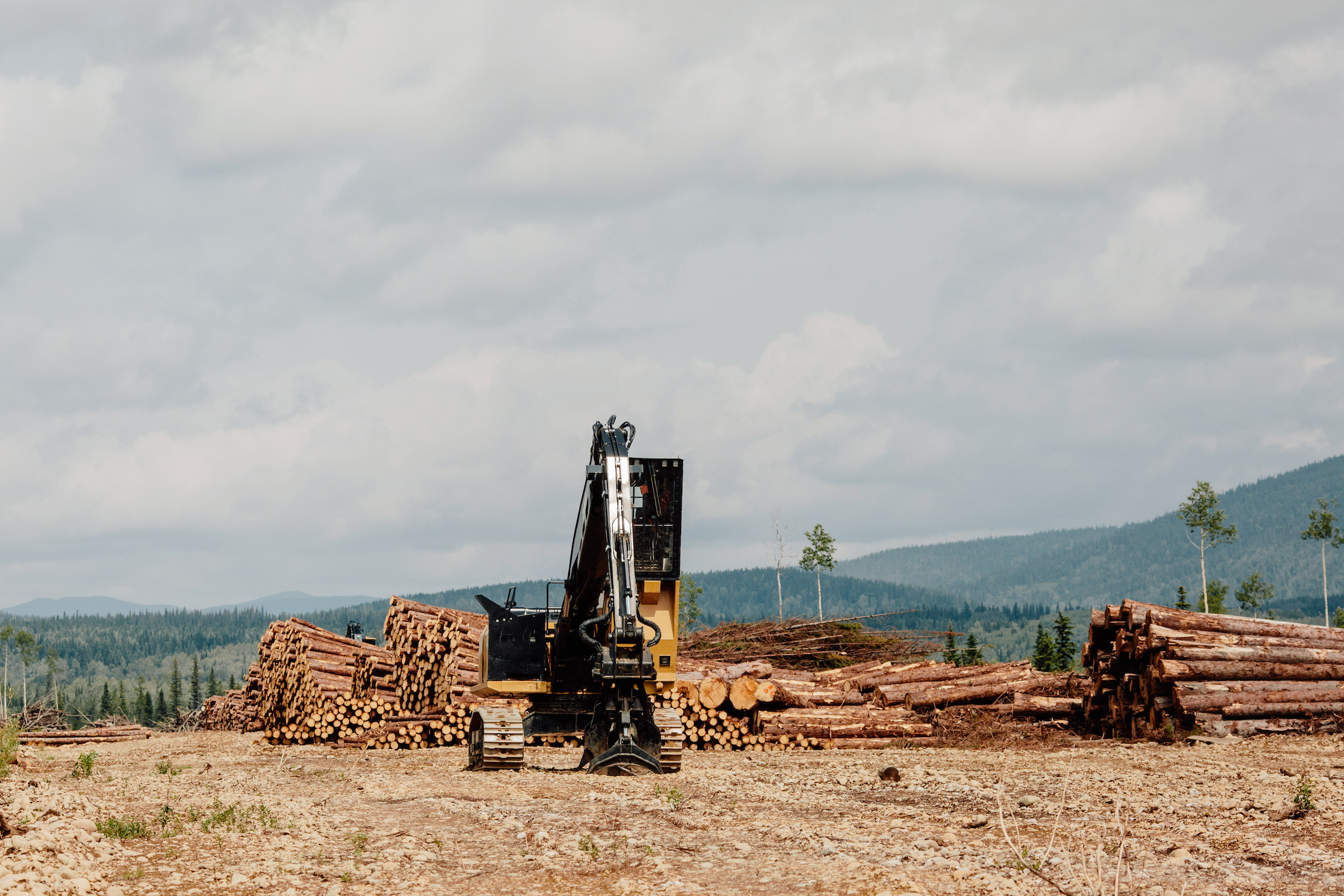
Piles of spruce logs line the ground in a fresh clear cut in the Anzac Valley. Photo: Taylor Roades / The Narwhal
Scientists have studied spruce beetle outbreaks in U.S. national forests, comparing areas that were left alone to areas that were logged, said Six.
“And the ones that basically were left alone are recovering much faster.”
Thousands of dollars are now being spent on “snag management” across U.S. western states in order to save bird populations whose habitat has been destroyed by clear-cut logging, Six points out.
Snags — dead or dying standing trees, often missing their tops — are used by woodpeckers and other birds for nesting.
A recent survey of more than 500 bird species in Canada and the U.S. found that more than three billion birds have been lost since 1970.
“We’re losing birds so fast we’ve got to get some of these things back,” Six says.
The U.S. forest service is now finding ways to damage big trees so they will rot faster and provide nesting habitat and insect food sources eliminated by clear-cut logging.
“And as a wonderful side effect of getting back your bird species you help manage your insect pests,” Six says.
Rea says the swath of red across interior forests attacked by the spruce beetle creates the impression that the forest is dead, especially from the air.
“But as soon as you get under that spruce crown there’s a lot of life in many of these forest stands … I don’t think we should say, ‘the overstory trees are dead, we need to clear the whole thing,’ ” Rea says.
“Every single tree that you can leave standing, even it it’s a little teeny willow or a subapline fir, if it’s got leaves on it or it’s got needles on it and it can soak up carbon, let it do that.”
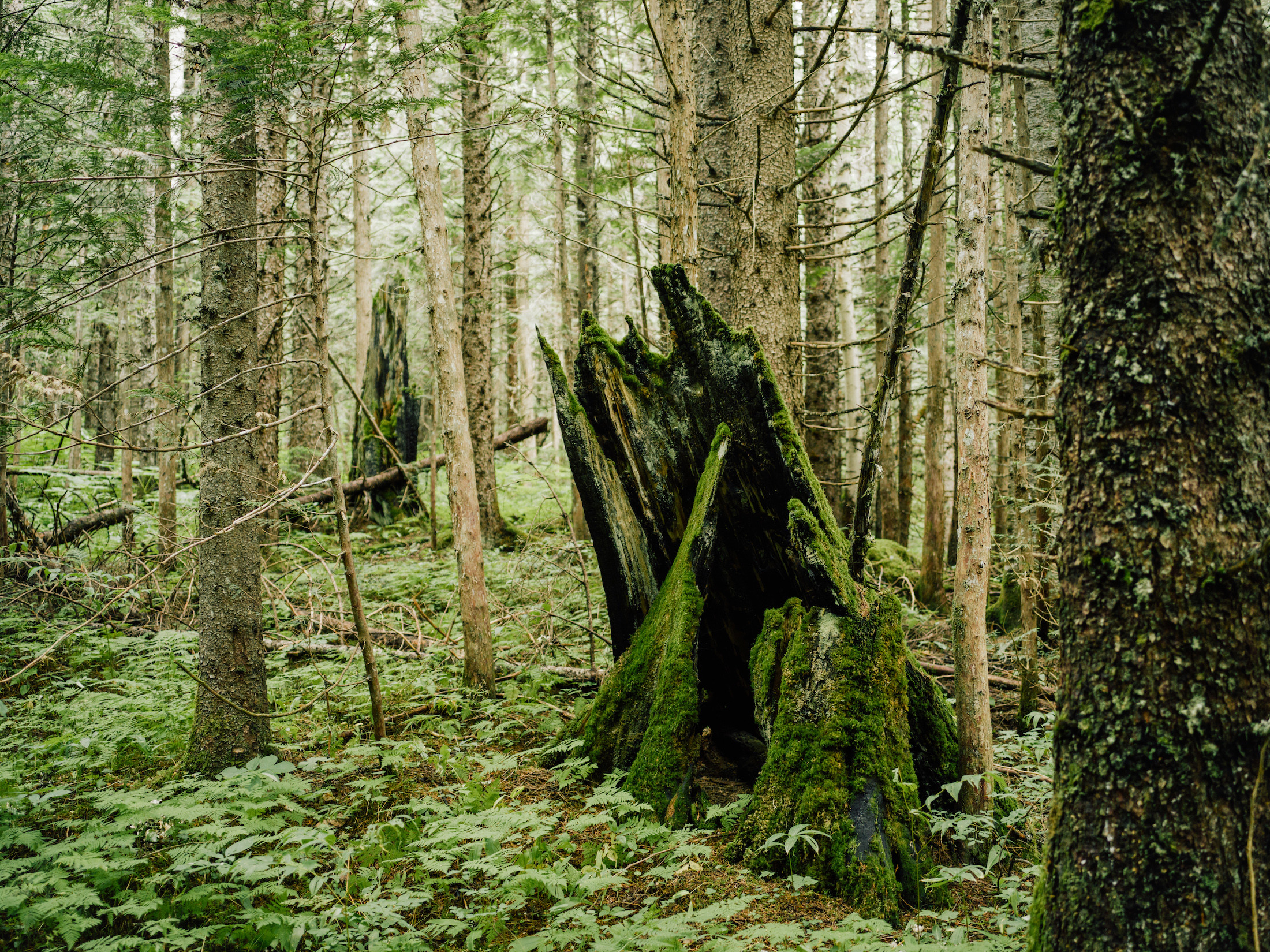
The understory in old-growth forests provides habitat for numerous species. Photo: Taylor Roades / The Narwhal
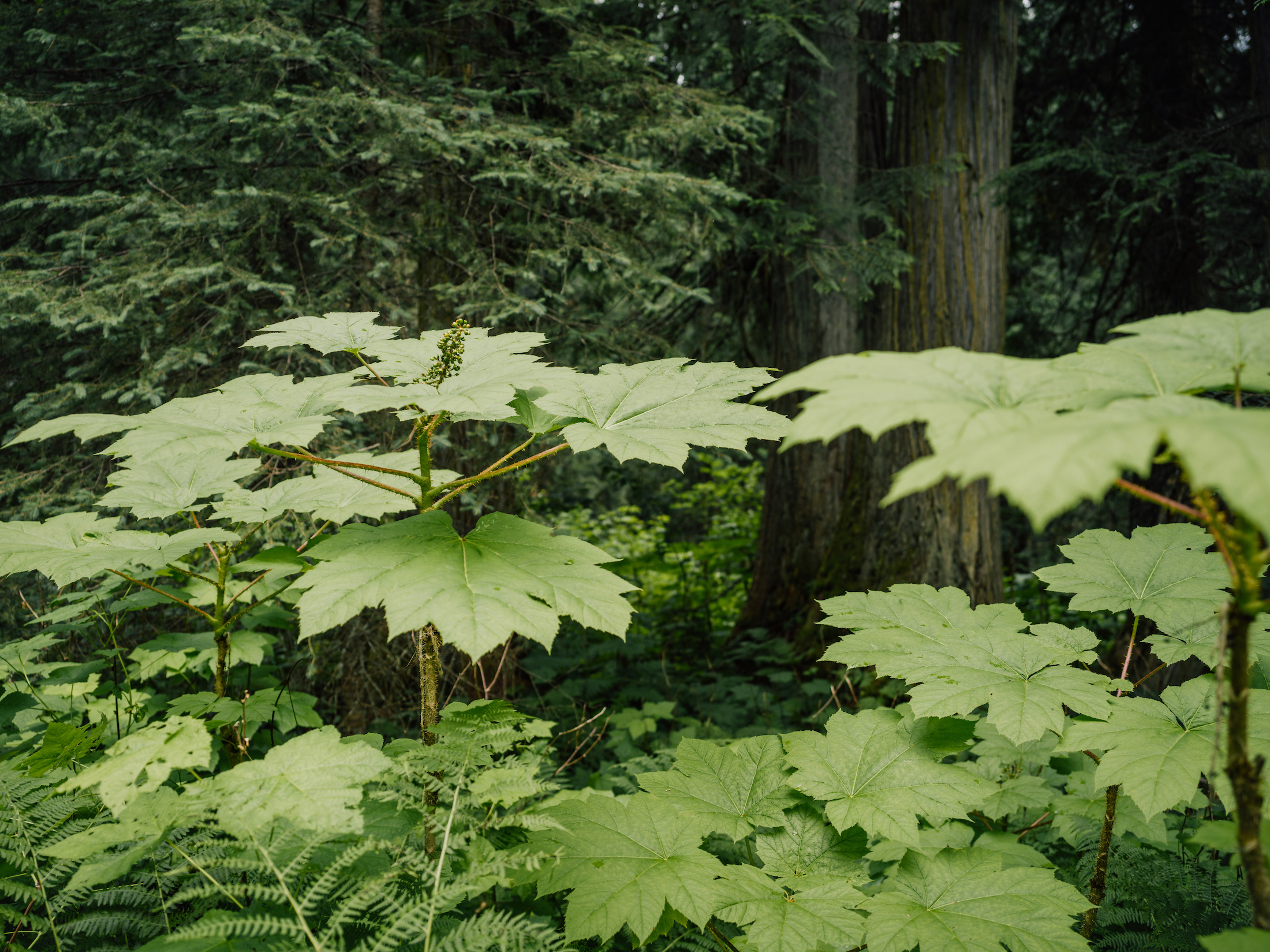
Old-growth understory. Photo: Taylor Roades / The Narwhal
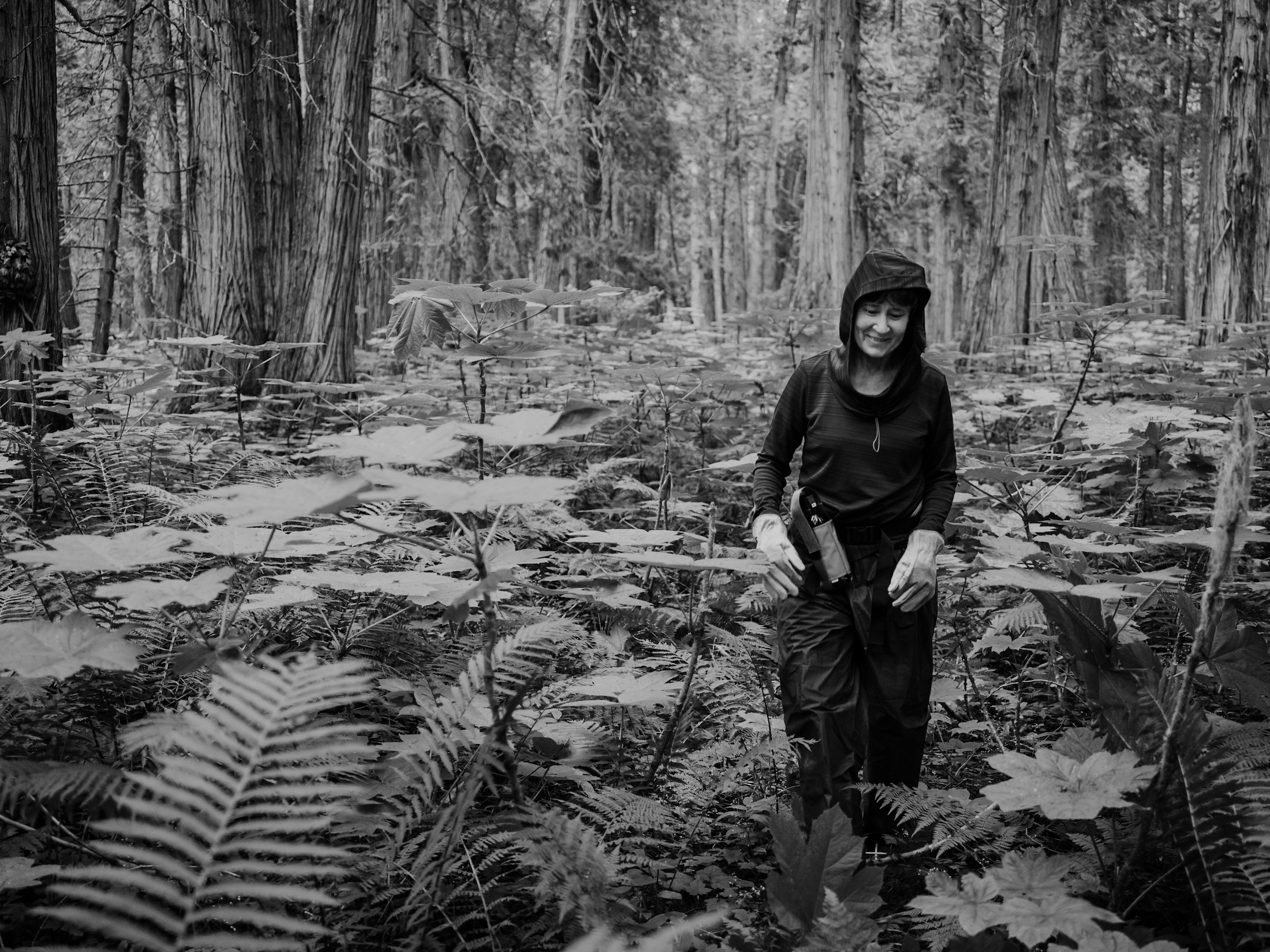
Journalist Sarah Cox traverses old-growth understory that can easily grow to shoulder height, wearing coveralls and gloves for protection against spiky Devil’s Club. Photo: Taylor Roades / The Narwhal
Instead of piling up wood waste from clear-cutting and burning it, contributing to greenhouse gas emissions, leaving it on the ground would create habitat for wildlife such as voles, mice, shrews and salamanders, which in turn feed other wildlife that themselves perform important ecosystem services, Rea says.
Leaving behind more trees not only retains biodiversity and ecosystem services but it also nurtures secondary stand structure that can help meet mid-term timber supply needs, Rea says.
“We’re knocking down a lot of trees that end up in burn piles and, if left standing, in 20 or 30 years could be on their way to the sawmill.”
Get the inside scoop on The Narwhal’s environment and climate reporting by signing up for our free newsletter. A $335 million funding commitment to fund...
Continue reading
First Nations are leading efforts to make sure lake sturgeon can find a home in...

We’re excited to share that an investigation by The Narwhal is a finalist for the...

A new documentary, Nechako: It Will Be a Big River Again, dives into how two...
